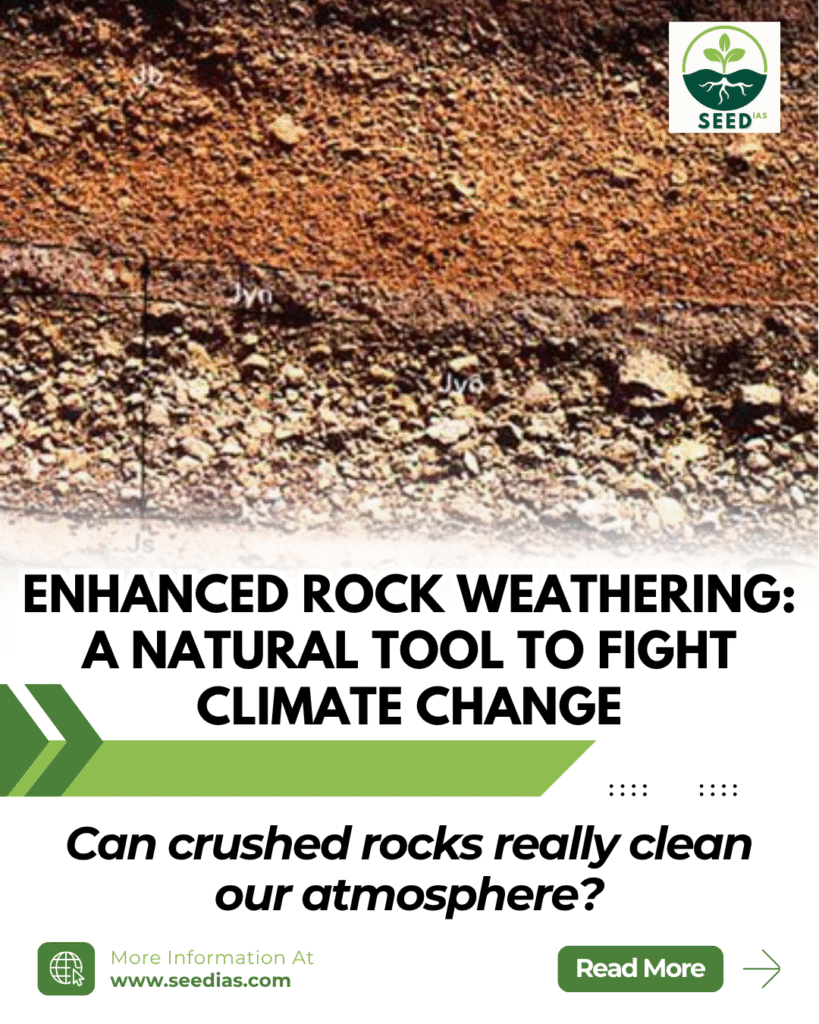Why in NEWS
Enhanced Rock Weathering (ERW) is gaining global attention as a nature-based solution to capture carbon dioxide, with recent trials across continents and major investments from companies like Google.
Key Concepts and Definitions
| Term | Explanation |
|---|---|
| Enhanced Rock Weathering (ERW) | Technique of spreading crushed basalt on farmland to speed up CO₂ absorption. |
| Carbon Sequestration | Process of capturing and storing atmospheric carbon dioxide long-term. |
| Basalt | A volcanic rock rich in minerals, commonly used in ERW due to its high weathering potential. |
| Carbon Credit | A permit that allows emission of a certain amount of carbon dioxide or other greenhouse gases. |
News Details
Enhanced Rock Weathering speeds up the natural weathering of rocks like basalt, capturing carbon dioxide from the atmosphere. The CO₂ reacts with minerals to form stable carbonates over time, storing carbon in soil and water. Trials are ongoing across the globe, and companies like Google are investing heavily in this emerging climate solution.
Objectives and Key Features
| Feature | Details |
|---|---|
| Process | Crushed rock (mainly basalt) is spread over farmland, where it reacts with CO₂ and water to form bicarbonates. |
| Speed | Grinding rocks increases surface area, accelerating the reaction rate. |
| Soil Benefits | Raises soil alkalinity, boosts crop yield, and reduces soil acidification. |
| Climate Benefit | Potentially removes significant amounts of CO₂ per hectare over time. |
| Trials and Use | Implemented in India, US, Brazil; Google and Mati Carbon are key players. |
Significance
| Aspect | Insight |
|---|---|
| Climate Impact | Some studies show removal of 10.5 tonnes CO₂/hectare over 4 years. |
| Agriculture | Improves crop health and resilience by enhancing soil quality. |
| Risks | Overestimation of captured CO₂ may distort carbon markets. |
| Concerns | Potential release of heavy metals from certain rocks, requiring careful rock selection. |
In a Nutshell
Memory Code: “CRUSH IT: Carbon Removal Using SHredded Igneous Terrain”
ERW is a promising tool blending geology and agriculture to fight climate change, but it needs more data and regulation to ensure true climate benefit.
Prelims Practice Questions
- What is the main geological material used in Enhanced Rock Weathering (ERW)?
a) Limestone
b) Granite
c) Basalt
d) Sandstone - Which of the following is NOT a benefit of ERW?
a) Soil alkalinity improvement
b) Ocean acidification
c) Carbon sequestration
d) Fertility enhancement - Which country issued the first verified ERW carbon credits?
a) India
b) USA
c) Germany
d) Brazil
Mains Practice Questions
- (GS Paper 3 – Environment)
Discuss the science, benefits, and limitations of Enhanced Rock Weathering (ERW) as a method of carbon dioxide removal. - (GS Paper 3 – Agriculture/Climate Change)
Evaluate the role of ERW in sustainable agriculture and climate mitigation. How can India integrate this into its climate policy?
Answer Key for Prelims Questions
| Q.No | Correct Answer | Explanation |
|---|---|---|
| 1 | c | Basalt is widely used due to its high weathering capacity and mineral content. |
| 2 | b | ERW helps prevent ocean acidification but does not cause it. |
| 3 | d | Brazil was the first to issue verified carbon credits from ERW activities. |
















